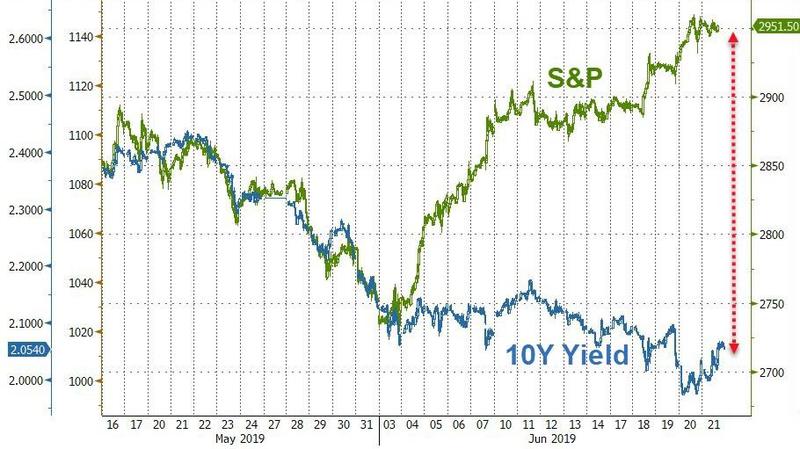U.S. stocks, bonds, gold and oil are all rallying together this week, sustained by the Federal Reserve reassurance that it may lower interest rates soon to help offset the “cross currents” in the global economy generated by the Trump administration’s erratic trade policy.
But the rally may now be dependent on the outcome of this week’s G-20 leaders meeting in Japan, where it is hoped another truce in President Donald Trump’s trade war with China will assuage all fears, but investors may be missing the bigger picture.
U.S. stocks rallied to new records last week after the Federal Reserve’s suggestion, repeated by Fed Chairman Jerome Powell as recently as Tuesday, that easier monetary policy may be on the horizon.
The Dow Jones Industrial Average DJIA, -0.67% is within 1% from its all-time high of 26,828.39 set last October, while the S&P 500 index SPX, -0.95% hit its most recent record at 2,964.15 last Thursday, climbing some 6.8% so far in June, and is up nearly 25% from a Dec. 24 nadir.
Investors hope that Trump and Chinese President Xi Jinping will strike an accord in Osaka, Japan, similar to the cease-fire achieved at the meeting last year of major developed economies in Argentina.
Read: U.S. to delay China tariffs after Trump-Xi dinner meeting at G-20 in Buenos Aires
If not, the U.S. authorization to levy tariffs on a further $300 billion of imports from China is due to take effect in early July.
The market consensus expects a possible detente in Osaka but no substantive agreement. An agreement of any kind, however, might not matter
Indeed, the damage to U.S. and global economies may already have been done with the imposition of import tariffs that are disrupting manufacturers’ supply chains, eroding business confidence and investment, and raising prices for business and consumers.
“Investors beware: while a pause (in the trade war) is better than escalation, it won’t refresh the economy enough to forestall a challenging path for risk assets,” Morgan Stanley strategist, Michael Zezas wrote in a note this week.
“A pause, particularly one that comes without preconditions and follows a period of heated rhetoric, would be positive, signaling that both sides want to avoid further economic damage,” Zezas said.
“If it coincides with Fed dovishness, a pause could boost investor sentiment and risk asset prices in the short term. However, we’d view this more as a set-up to sell risk than a catalyst to turn more bullish,” he warned.
Moreover, a U.S.-China agreement to keep negotiating on trade doesn’t mean they’ve made any progress on the points that divide them: codifying intellectual property protections, opening up China to more foreign investment, measures to rebalance the trade deficit, and the timing of the removal of existing tariffs.
Import tariffs have already impacted the global economy judging by both manufacturing and service sector activity indices. IHS Markit’s purchasing managers indexes have registered a slower pace of activity since 2018, driven mainly by trade tensions. Both the International Monetary Fund and Organization for Economic Co-operation and Development are forecasting slower expansion in the U.S. and globally for 2019.
Second-quarter U.S. corporate earnings, due to be reported in July, may also reflect the damage wrought by Trump’s trade war.
Second-quarter results for companies in the S&P 500 index are expected to fall by 2.6%, according to FactSet data, which would be the first two straight quarters of year-over-year declines in earnings since Q1 2016 and Q2 2016, according to FactSet senior analyst John Butters.
“Trump’s tariffs fly in the face of one of the 20th century’s greatest policy blunders — the Smoot-Hawley Tariff of 1930, which sparked a 60% plunge in global trade by 1932,” Yale economist, and former Morgan Stanley chief economist, Stephen Roach warned. “With foreign trade currently accounting for 28% of GDP, versus 11% in 1929, the U.S., as a debtor country today, is far more vulnerable to trade-related disruptions than it was as a net creditor back then.”
A Fed reluctant to pull the trigger on expected interest rate cuts may prove the biggest risk to the gains in asset markets. At the Council on Foreign Relations in New York on Tuesday, Powell said that the question the rate-setting Federal Open Market Committee is “grappling with is whether these uncertainties will continue to weigh on the outlook and thus call for additional policy accommodation.”
And if policy makers are reluctant to cut interest rates by as much as the Wall Street is hoping, the market could be in for a rough ride. CME Group data tracking federal-funds rates show that investors are betting on at least a 50 basis point rate cut this year and a near-certain, quarter-of-a-percentage-point rate cut when the FOMC next gathers July 30-31.
“This is a major risk for equity markets going forward: if central banks fail to validate over the coming months market expectations of universal rate cuts, equities could be hit not only by a potential selloff in bonds that would mechanically make investors more overweight in equities, but also by a potential increase in cash allocations as investors cover their currently extreme cash underweight,” said JPMorgan Chase strategist, Nikolaos Panigirtzoglou.
The chart below illustrates the climb in the broad-market S&P 500 index against the decline in bond yields over the past year:
 Source: JPMorgan
Source: JPMorgan








